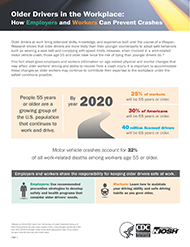Older Drivers in the Workplace: How Employers and Workers Can Prevent Crashes
March 2016
DHHS (NIOSH) Publication Number 2016-116

Older drivers at work bring extensive skills, knowledge, and experience built over the course of a lifespan. Research shows that older drivers are more likely than their younger counterparts to adopt safe behaviors such as wearing a seat belt and complying with speed limits. However, those age 55 and older have twice the risk of dying in a work-related crash than younger workers do. One possible reason is that older persons are more likely to be injured if they are in a crash, and more likely to die if they are injured.
This fact sheet gives employers and workers information on age-related physical and mental changes that may affect older workers’ driving. It is important to accommodate these changes so older workers may continue to contribute their expertise to the workplace under the safest conditions possible.
Older Drivers in the Workplace: How Employers and Workers Can Prevent Crashes [PDF – 1.38 MB]
Suggested Citation
NIOSH [2016]. Older drivers in the workplace: how employers and workers can prevent crashes. By Rodriguez-Acosta R., Pratt S. and Olsavsky, R. Morgantown, WV: U.S. Department of Health and Human Services, Centers for Disease Control and Prevention, National Institute for Occupational Safety and Health, DHHS (NIOSH) Publication 2016–116.
